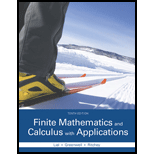
Concept explainers
Elasticity The price along the West Coast of the United States for Japanese spruce logs (in dollars per cubic meter) based on the demand (in thousands of cubic meters per day) has been approximated by
Source: Kamiak Econometrics.
(a) Find the elasticity when the demand is 11 thousand cubic meters a day. (Hint: To find dq/dp when p is expressed in terms of q, you may use the fact that
Review the explanation of the derivative of the natural logarithm to see why this is true.)
(b) Is the demand for spruce logs elastic or inelastic?
(c) What happens to the elasticity as q approaches 16.6887? Discuss the limitations of this model for the price as a function of the demand.
Want to see the full answer?
Check out a sample textbook solution
Chapter 14 Solutions
Finite Mathematics and Calculus with Applications (10th Edition)
- Question 2 Find the shortest distance between the lines [x, y, z] = [1,0,4] + t[1, 3, −1] and [x, y, z] = [0,2,0] + s[2, 1, 1]. [Do not use derivatives.]arrow_forwardPlease see image for the questions.arrow_forwardUse the following graphs to evaluate the given one-sided limit. Answer exactly. y = f (x): y = g(x): 8 6 ν -8-6-4-2 2- 1-2-2 -4 -6 -8 ° 4 lim (f(x)+g(x)) = x+2+ 8 6 2 ν 0 x x 6 8 -8 -6-4-2 2 6 8 -2 -4 -6 -8arrow_forward
- Question 1 The points A = (-2, 3, 2) and B = (4, 1, 4) are reflections of one another in a plane S. Find an equation for S.arrow_forwardThe graph below is the function f (x) -D -3-2 4 3 2 Q2 03 Find lim f(x) = x-1- Find lim f(x) = x−1+ Find lim f(x) = x-1 Find f (-1) = 3 4 5arrow_forwardi circled the correct answer and i did most of the question but i cant figure out how to add both residues to get the correct answer could you please show me how to do itarrow_forward
- Question 3 Starting at the point (0, −2,0), I walk up the hill z = 4-x² — y². The projection of my path on the xy plane is the line y = 2x-2. (a) At what point on my path is my altitude (the z-value) the greatest? (b) What is the slope m of my path (taking the z-axis to be vertical) when I am at the point (1, 0, 3)? [Hint: Parametrize my path (take x to be t).]arrow_forwardI circled the correct, could you explain using stokearrow_forwardUse Euler's method to numerically integrate dy dx -2x+12x² - 20x +8.5 from x=0 to x=4 with a step size of 0.5. The initial condition at x=0 is y=1. Recall that the exact solution is given by y = -0.5x+4x³- 10x² + 8.5x+1arrow_forward
- Find an equation of the line tangent to the graph of f(x) = (5x-9)(x+4) at (2,6).arrow_forwardFind the point on the graph of the given function at which the slope of the tangent line is the given slope. 2 f(x)=8x²+4x-7; slope of the tangent line = -3arrow_forwardUse the product rule to find the derivative of the following. p(y) (y¹ + y²) (6y¯³-10y¯4)arrow_forward
- Algebra & Trigonometry with Analytic GeometryAlgebraISBN:9781133382119Author:SwokowskiPublisher:Cengage
 Algebra and Trigonometry (MindTap Course List)AlgebraISBN:9781305071742Author:James Stewart, Lothar Redlin, Saleem WatsonPublisher:Cengage Learning
Algebra and Trigonometry (MindTap Course List)AlgebraISBN:9781305071742Author:James Stewart, Lothar Redlin, Saleem WatsonPublisher:Cengage Learning Functions and Change: A Modeling Approach to Coll...AlgebraISBN:9781337111348Author:Bruce Crauder, Benny Evans, Alan NoellPublisher:Cengage Learning
Functions and Change: A Modeling Approach to Coll...AlgebraISBN:9781337111348Author:Bruce Crauder, Benny Evans, Alan NoellPublisher:Cengage Learning  Big Ideas Math A Bridge To Success Algebra 1: Stu...AlgebraISBN:9781680331141Author:HOUGHTON MIFFLIN HARCOURTPublisher:Houghton Mifflin Harcourt
Big Ideas Math A Bridge To Success Algebra 1: Stu...AlgebraISBN:9781680331141Author:HOUGHTON MIFFLIN HARCOURTPublisher:Houghton Mifflin Harcourt
 Glencoe Algebra 1, Student Edition, 9780079039897...AlgebraISBN:9780079039897Author:CarterPublisher:McGraw Hill
Glencoe Algebra 1, Student Edition, 9780079039897...AlgebraISBN:9780079039897Author:CarterPublisher:McGraw Hill





